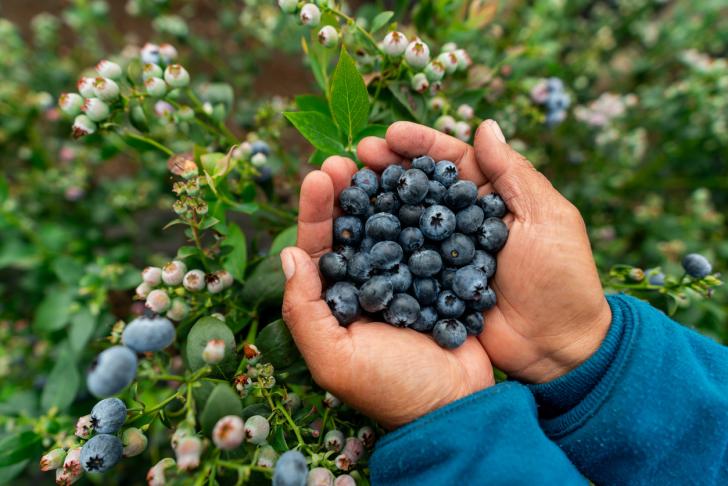Which Milk Alternative is the Most Eco-Friendly?

Published
Are you someone who thinks that plant-based milks are all eco-friendly? If so, read on to see how you can make the most environmentally friendly decision when choosing your plant-based milk.
The Switch from Dairy to Plant-Based Milks
Because dairy milk requires many resources to produce, it is not the most eco-friendly option. When compared to plant-based milk, dairy milk requires nine times as much land to produce.1 Some consumers have shifted to purchasing plant-based milks as an eco-friendlier option. However, plant-based alternatives are not equal in their eco-friendliness, so each person needs to determine for themselves which factors are most important.
Almond Milk
When looking at greenhouse gases or land use, almonds are about the same in comparison to other plant-based milks. However, almond milk has one of the largest water footprints out of plant-based milk alternatives. Farmers need a large amount of water to produce almonds. In fact, it takes 3.2 gallons of water to produce one almond.2 If water conservation is important to you, you may want to choose another plant-based milk.
Soy Milk
In terms of plant-based milk alternatives, soy milk has been around much longer than other alternatives. Soybeans use less than a tenth of water that almonds do, and the greenhouse gases produced by soy production are much less than dairy milk. Soy production contributes to deforestation, especially in the Amazon rainforest. One study found that one square mile of land is required per year to produce a 4-cup or one liter serving of soy milk.1 To make a more eco-friendly choice, choose soy milk made from organic soybeans grown in the United States. This product does not result in deforestation of the Amazon rainforest.
Rice Milk
Rice requires large amounts of water to produce. This places a strain on water resources. Additionally, rice crops give off a gas called methane which is a greenhouse gas that contributes to global warming.3 For rice grown in the US, farmers use pesticides to control weeds and insects. The pesticides used on rice crops in the US can run off into water supplies. This can ultimately cause water pollution. Choosing organic rice milk can eliminate pesticide concerns. In comparison with soy, oat, and almond production, rice does use less land resources.1 If land conservation is important to you, this may be a great product to choose. However, it is not the best product when looking at greenhouse gases, water pollution, and water footprint.
Oat milk
Oat milk typically uses the least water when compared to other plants turned into milk.4 It also has a relatively low greenhouse footprint. Oat milk also uses 80 percent less land than dairy milk, but uses more land resources when compared to soy, almond, and rice.1 One concern is some conventional oats have been shown to be contaminated with unsafe levels of glyphosate, which is a herbicide used to kill weeds. If purchasing oat milk, try to choose organic varieties to avoid pesticide usage. Overall, oat milk is an eco-friendly option when looking at water and land usage as well as greenhouse gas production.
Hemp Milk
Hemp is a high yielding, sustainable crop that is able to grow in a range of climates. All parts of the plant can be utilized which makes it very eco-friendly.6 The seed can be used for hemp oil and milk. The stalk and roots of the plant make commercial items like paper, rope, or plastics. Hemp also requires less herbicides and pesticides than other crops due to its natural resistant to diseases. Hemp does require more water to grow than oat, soy, or pea plants, but requires less than almond. Hemp is an overall eco-friendly option.
Pea milk
Pea milk is one of the newer plant-based milk alternatives and is very similar to soy milk. It also produces a low amount of greenhouse gases when compared to dairy milk. Peas have the ability to fix nitrogen into the soil.6 This ultimately reduces the need for nitrogen fertilizers. Peas also require less water than many other crops and are typically grown in areas where water is less scarce.4 Pea milk does have a grassier flavor when compared to other plant-based milks, so may be one thing to consider when purchasing.
How to Choose the Most Environmentally Friendly Milk
Plant-based milk has a smaller impact on water and land as well as carbon emissions when compared to dairy milk. Overall, soy, oat, hemp, and pea milks are more eco-friendly choices than almond or rice milk. To help strengthen your environmental decisions, choose plant-based milks that come in a recyclable container. This will help reduce waste. Try to purchase organic plant-based milks. This ensures ingredients are grown without pesticides that can harm soil and pollute water and air. The bottom line is you need to let your environmental values help guide your decision when choosing a plant-based milk alternative.
Bastyr Center for Natural Health Clinic supports making eco-friendly choices to nourish the planet. Schedule a visit today by calling 206-834-4100 or visit the Bastyr Center for Natural Health Clinic at www.bastyrcenter.org.
About the Author
Jena Williams is a dietetic intern at Bastyr University in Kenmore, WA. She is passionate about helping individuals nourish a healthy relationship with food and their body. Her areas of interest include women’s health and hormonal problems, integrative and functional medicine, eating disorder treatment, and intuitive eating.
References
-
Poore J, Nemecek T. Reducing food's environmental impacts through producers and consumers [published correction appears in Science. 2019 Feb 22;363(6429):]. Science. 2018;360(6392):987-992. doi:10.1126/science. aaq0216
-
Fulton J, Norton M, Shilling F. Water-indexed benefits and impacts of California almonds. Ecological Indicators. https://www.sciencedirect.com/science/article/pii/S1470160X17308592#b0170. Published April 9, 2018. Accessed January 31, 2022.
-
Gorh D, Baruah KK. Estimation of methane and nitrous oxide emission from wetland rice paddies with reference to global warming potential. Environ Sci Pollut Res Int. 2019;26(16):16331-16344. doi:10.1007/s11356-019-05026-z
-
Mekonnen M, Hoekstra A. The Green, Blue and Grey Waterfootprint of Crops and Derived Crop Products. https://waterfootprint.org/media/downloads/Report47-WaterFootprintCrops-Vol2.pdf. Published December 2010. Accessed March 5, 2022.
-
Piotrowski S, Carus M. Ecological benefits of hemp and flax cultivation and products. https://www.researchgate.net/publication/267766816_Ecological_benefits_of_hemp_and_flax_cultivation_and_products. Published 2011. Accessed January 31, 2022.
-
Flynn R. Nitrogen fixation by legumes. NMSU. https://aces.nmsu.edu/pubs/_a/A129/. Published June 2015. Accessed March 5, 2022.


